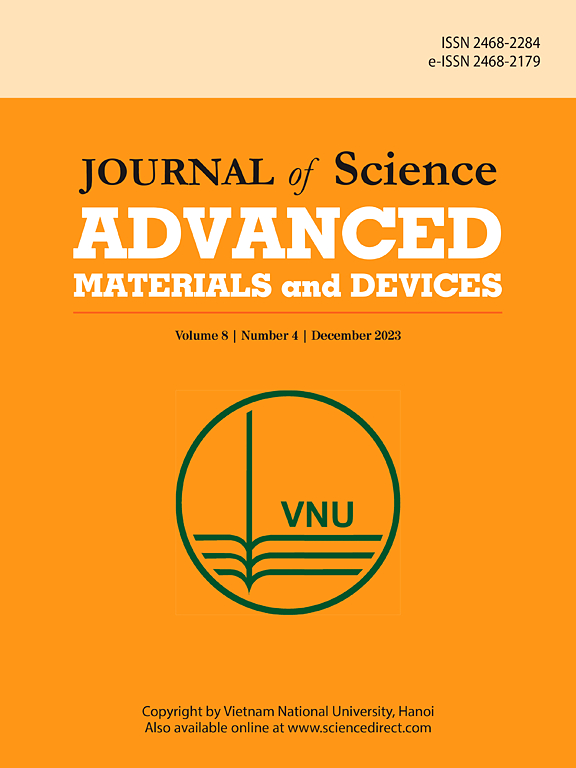Preparation and investigation of structural, optical, and dielectric properties of PVA/PVP blend films boosted by MWCNTs/AuNPs for dielectric capacitor applications
IF 6.7
3区 材料科学
Q1 MATERIALS SCIENCE, MULTIDISCIPLINARY
Journal of Science: Advanced Materials and Devices
Pub Date : 2024-10-09
DOI:10.1016/j.jsamd.2024.100802
引用次数: 0
Abstract
With the rising global energy demands, there is a pressing need for the invention of efficient and reliable energy storage systems. This research centers on the creation and analysis of flexible dielectric capacitors composed of polymer nanocomposites (PNCs), incorporating a blend of polyvinyl alcohol (PVA) and polyvinyl pyrrolidone (PVP) as the base polymer, with multi-walled carbon nanotubes (MWCNTs) and gold nanoparticles (AuNPs) serving as nanofillers. The AuNPs were produced through an environmentally friendly synthesis method. Films made from PVA/PVP blended with MWCNTs and AuNPs were fabricated using the casting approach. Various characterization methods, including TEM, XRD, FTIR, and UV–Vis spectroscopy, were utilized to evaluate the samples. A detailed analysis of their electrical/dielectric characteristics was conducted. XRD analysis revealed a significant decrease in crystallinity from 55% for the pure PVA/PVP blend to 37% for the 1.6 wt% nanofiller composite, indicating increased amorphous content, which facilitates better ion mobility. FTIR confirmed strong interactions between the polymer matrix and nanofillers, with intensified vibrational peaks pointing to enhanced molecular dynamics. UV–Vis spectroscopy demonstrated a red shift in the absorption edge, and Tauc plot analysis showed a reduction in the indirect/direct optical band gap from 4.84 eV/5.68 eV for the pure blend to 4.26/5.35 eV for the nanocomposite with 1.6 wt% nanofillers. The addition of nanofillers resulted in improvements in their dielectric features, which exhibited a significant performance improvement, with the dielectric constant (ε′) reaching approximately 1100 at low frequency for the 1.6 wt% nanofiller sample, compared to 9 for the pure blend. Additionally, the dielectric loss (ε'') and tangent loss (tan δ) were reduced, with tan δ showing a decrease from 15 for the pure blend to 2 for the 1.6 wt% nanofiller composite at low frequency, indicating enhanced dielectric efficiency and reduced energy dissipation. The capacitors' functionality was assessed through capacitance-frequency and conductance-frequency analyses. The capacitors exhibited stable high capacitance across a broad frequency spectrum, making them alternatives for energy storage solutions.
制备和研究用于电介质电容器应用的由 MWCNTs/AuNPs 助长的 PVA/PVP 混合薄膜的结构、光学和介电性质
随着全球能源需求的不断增长,迫切需要发明高效可靠的储能系统。本研究的重点是创建和分析由聚合物纳米复合材料(PNCs)组成的柔性介质电容器。PNCs 以聚乙烯醇(PVA)和聚乙烯吡咯烷酮(PVP)的混合物为基础聚合物,以多壁碳纳米管(MWCNTs)和金纳米粒子(AuNPs)为纳米填料。AuNPs 是通过一种环境友好型合成方法生产的。采用浇铸法制作了由 PVA/PVP 与 MWCNTs 和 AuNPs 混合而成的薄膜。利用各种表征方法,包括 TEM、XRD、FTIR 和 UV-Vis 光谱,对样品进行了评估。对样品的电气/介电特性进行了详细分析。XRD 分析表明,结晶度从纯 PVA/PVP 混合物的 55% 显著下降到 1.6 wt% 纳米填料复合材料的 37%,表明无定形含量增加,这有利于提高离子迁移率。傅立叶变换红外光谱证实了聚合物基体和纳米填料之间强烈的相互作用,振动峰的增强表明分子动力学增强。紫外可见光谱显示吸收边缘发生了红移,Tauc 图分析表明间接/直接光带隙从纯共混物的 4.84 eV/5.68 eV 减小到含有 1.6 wt% 纳米填料的纳米复合材料的 4.26/5.35 eV。纳米填料的添加改善了介电特性,表现出显著的性能改善,1.6 wt%纳米填料样品的介电常数(ε′)在低频时达到约 1100,而纯混合物的介电常数为 9。此外,介电损耗(ε'')和正切损耗(tan δ)也有所降低,在低频下,tan δ 从纯混合物的 15 降至 1.6 wt% 纳米填料复合材料的 2,表明介电效率提高,能量耗散降低。电容器的功能通过电容-频率和电导-频率分析进行了评估。这些电容器在宽频谱范围内表现出稳定的高电容,使其成为能量存储解决方案的替代品。
本文章由计算机程序翻译,如有差异,请以英文原文为准。
求助全文
约1分钟内获得全文
求助全文
来源期刊

Journal of Science: Advanced Materials and Devices
Materials Science-Electronic, Optical and Magnetic Materials
CiteScore
11.90
自引率
2.50%
发文量
88
审稿时长
47 days
期刊介绍:
In 1985, the Journal of Science was founded as a platform for publishing national and international research papers across various disciplines, including natural sciences, technology, social sciences, and humanities. Over the years, the journal has experienced remarkable growth in terms of quality, size, and scope. Today, it encompasses a diverse range of publications dedicated to academic research.
Considering the rapid expansion of materials science, we are pleased to introduce the Journal of Science: Advanced Materials and Devices. This new addition to our journal series offers researchers an exciting opportunity to publish their work on all aspects of materials science and technology within the esteemed Journal of Science.
With this development, we aim to revolutionize the way research in materials science is expressed and organized, further strengthening our commitment to promoting outstanding research across various scientific and technological fields.
 求助内容:
求助内容: 应助结果提醒方式:
应助结果提醒方式:


